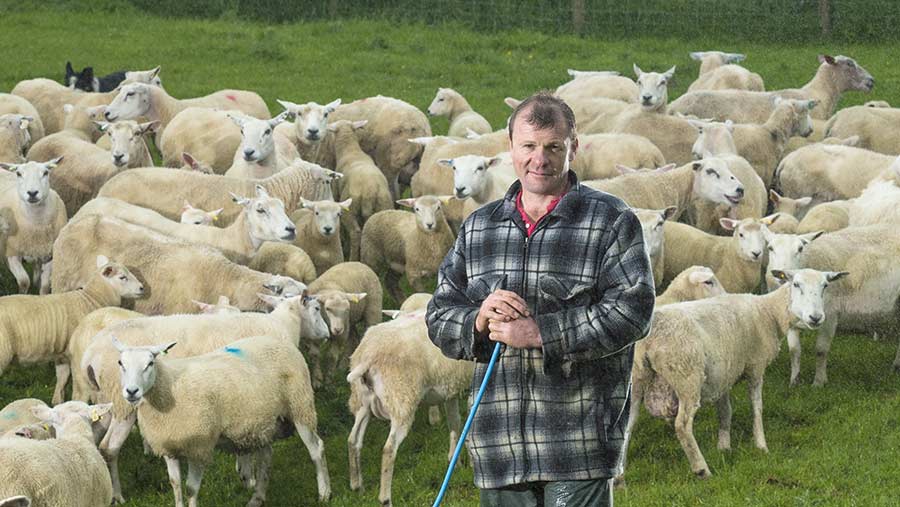How sheep farmer finishes and sells lambs in five months
 © Jim Varney
© Jim Varney March-born lambs reared on a dense clover ley at Duncan Nelless’ 566ha mixed organic farm achieve liveweight gains of 400g/day and the whole crop is sold within five months.
Thistleyhaugh Farm near Morpeth, Northumberland runs 1,900 Lleyn ewes and 600 ewe lambs. It is part of Signet’s genetic evaluation initiative – the RamCompare, so a wide range of tups are used including Texels, Charollais, Suffolks and Hampshires.
The lamb crop is split into two. One group is put to a terminal sire and run on rented clover leys at an organic arable unit 40 miles away. The second group is run at Thistleyhaugh and produces potential replacements along with finishers.
See also: Why Welsh sheep producers are more vulnerable to Brexit fallout
Growth rates for all groups are driven to exploit the efficiencies of early growth with weaning at about 12 weeks and finishing by the end of August. This gives the ewes the best chance of hitting the condition scores of 3-3.5 ahead of tupping.
Lamb group one: Paddock grazed on arable rotation land
In 2017, 773 lambs were finished off red clover and ryegrass leys on the arable rotation land. The clean land means the parasite challenge is minimal and the young grass and clover ley is high in protein.
Management input is lighter but paddocks are used to ensure grazing is always on young vegetative growth. Weekly weighing from eight weeks means no lamb is ever kept longer than necessary.
From an average birthweight of 5.02kg these March-born lambs reached 31.71kg liveweight at 75 days old.
Weaning took place at about 12-13 weeks with the lambs remaining on the familiar land while ewes are drawn off and taken back to Thistleyhaugh. This policy keeps stress for the lambs to a minimum and any weaning growth check is negligible.
Lamb performance of the 2017 arable rotation group
- First batch (126 sold, 12 June)
- Average weight 39.81kg
- Growth rate 430g /day.
- Overall group (773 sold, before 31 August)
- 40% achieved 400g/day growth rate
Lamb group two: Following suckler herd
The second group of lambs at Thistleyhaugh is subject to more detailed management.
Computer software programme Farmax, developed in New Zealand, is used to calculate dry matter availability.
The farm uses a sward stick to measure the clover and grass leys at least twice a month at heavy growth times.
This data is put into the software package which calculates dry matter availability based on other input values such as stock numbers, field history, weather and any previous cropping.
As the ewe is milking off her back as the lambs grow she must have 5% of her body weight in dry matter while the lambs need at least 3% to grow at a minimum of 250-300g/day, Mr Nelless says.
The sheep flock follows the farm’s suckler herd so that grazing offered is clean and always in a fresh, vegetative growth phase.
If the grass growth starts to get away a paddock system is introduced and excess ground shut off for hay or silage. To ensure there is no growth check from parasites, faecal egg counts are made at least twice in each group but worming is rarely needed due to the clean grazing policy.
At eight weeks 1,128 lambs in the 2017 crop achieved an average of 26kg or 290g a day.
For both groups, frequent weighing ensures no lambs are held beyond the optimum condition score. Lambs are sold early if the market is favourable rather than delaying selling to put on a bit of extra weight and risk a price fall as the season progresses.
It means the ewe has less competition for grass and she achieves the correct condition in time for tupping and the cycle begins again.
